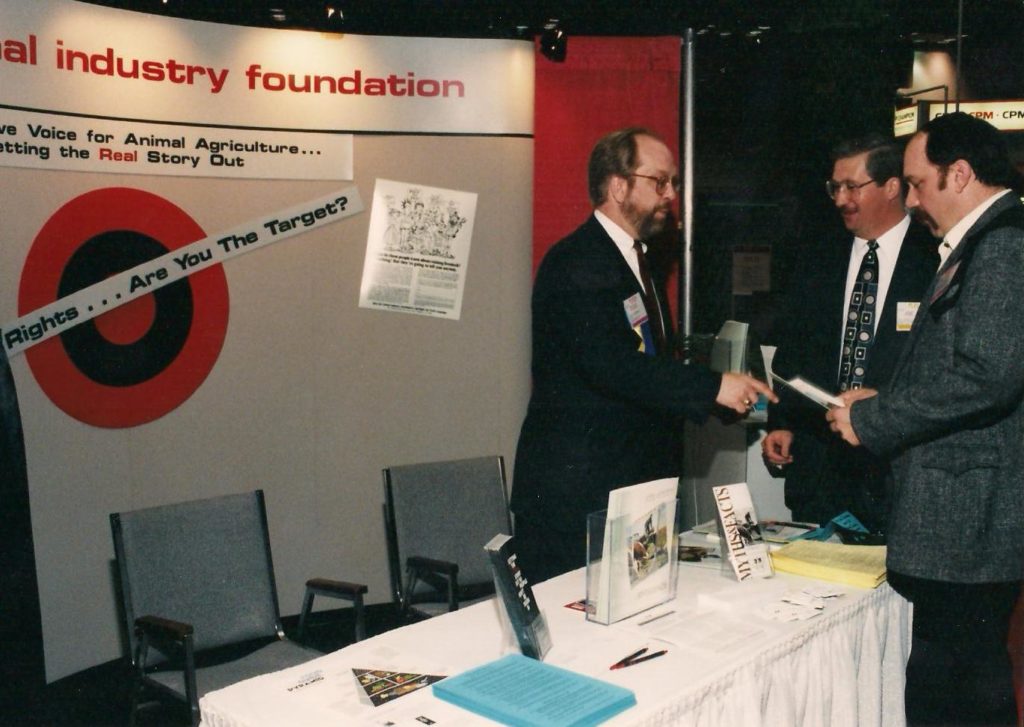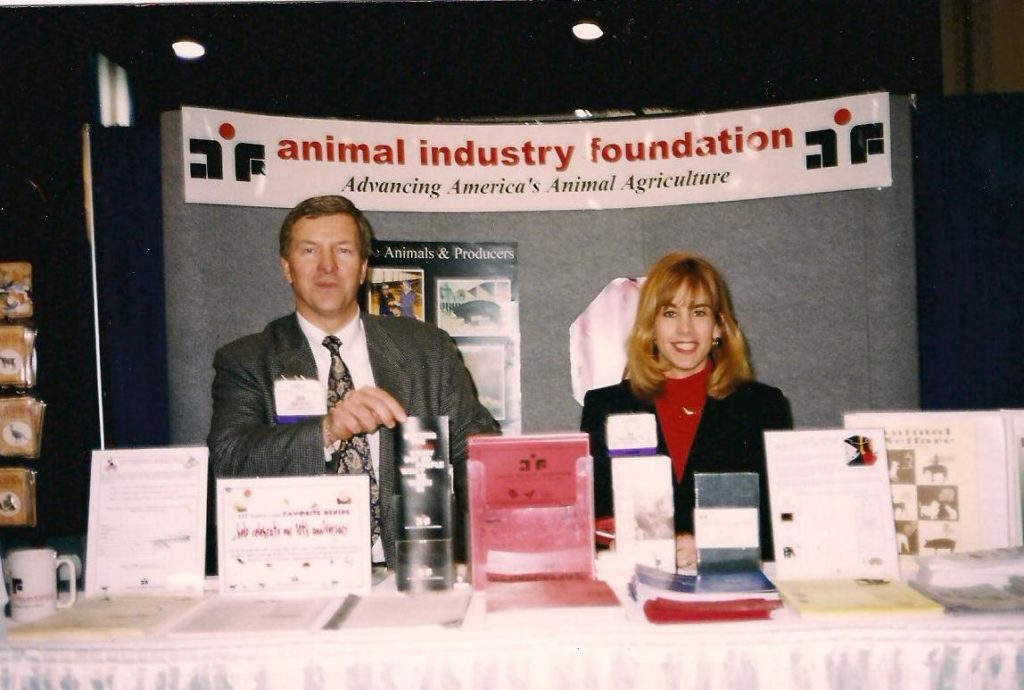Steve Kopperud, the first president of the Animal Industry Foundation, shares how the organization got its start and his experience with the animal rights movement.

I’m occasionally asked from where the notion came 30 years ago to create the Animal Industry Foundation, now the Animal Agriculture Alliance. Herein, I’ll commit the origins of the Alliance to the official “record” of its 30th anniversary recognition – as best I can recollect – but first, you have to indulge me – and this brief history lesson – as I expound on how legislative action spawns public education and outreach.
I first heard the term “animal welfare” applied to farm animals in 1980, from Dr. Howard Frederick, then the staff nutritionist for the “old” American Feed Manufacturers Association, now the American Feed Industry Association (AFIA). I was Washington, D.C. bureau chief for the American Broadcasting Company’s publishing division, which fed D.C. coverage to a host of ABC magazines, and Washington editor for Feedstuffs, the flagship of its Ag publishing books.
Dr. Frederick had returned from an animal nutrition conference in the United Kingdom (UK). He told me of the growing frustration among UK aggies over the increasing activist noise alleging routine mistreatment of farm animals. He also talked about the emerging animal rights movement.
My cynical reaction to Dr. Frederick’s report was, I think, pretty typical for the time: “How ‘European’ to worry about ‘happy’ pigs and chickens. That stuff will never catch on here.” U.S. animal right activists focused on animals used in biomedical research and ending the fur industry. I filed the issue in the back of mind, in that spot reserved for story ideas to be pursued later, if at all.

Shortly thereafter came the first U.S. public noise on animal rights from the Humane Society of the United States (HSUS). HSUS in the early 1980’s pushed for House legislation to “study” on-farm livestock production practices, the goal being to change those practices and federally regulate how farm animals were raised. The focus was on veal calves.
As a reporter, I took Dr. Frederick’s European experience combined with the HSUS agenda, and interviewed Dr. Michael W. Fox, the vice president of HSUS one afternoon in his office. The focus of the article would be “could the European situation happen here?” The article concluded the European “situation” was already happening in the U.S. The interview ran in Feedstuffs, and my phone didn’t stop ringing for a week. The vast majority of calls were from aggies outraged I would give Dr. Fox a forum to criticize without basis U.S. animal agriculture, and by default, farmers and ranchers.
In 1982, about 18 months after the Fox interview, I was hired by AFMA/AFIA to be its federal lobbyist. I worked with Dr. Frederick identifying evolving issues which could affect the commercial animal feed industry’s customers. In looking to Europe to see what, if any, issues were on the cusp of export to the U.S., “animal welfare” topped the list.
At first, I was a voice in the wilderness convincing livestock and poultry organizations of the threat of animal rights activism. Farmers and ranchers could not fathom anyone believing the activist message of senseless cruelty in pursuit of profit. I sat down with the American Farm Bureau Federation (AFBF) and the National Cattlemen’s Beef Association (NCBA), these groups having independently identified many of the same issues as AFMA/AFIA, as well as the HSUS “farm animal production practices” legislation.
Still, convincing some groups to take the issue as seriously as tax, food safety or trade legislation was tough. Consumers, based on contacts with ag groups, didn’t ask about on-farm production practices, housing, medications, feeds or animal transportation and processing. However, given the noise being made by HSUS, the newly launched People for the Ethical Treatment of Animals (PETA) and Animal Rights International (ARI) – including national newspaper ads, publicity stunts involving nude activists and the ensuing media attention – it wouldn’t be long before consumer head scratching evolved into consumer demands for change, for regulation and so forth.
AFMA, AFBF and NCBA founded the Farm Animal Welfare Coalition (FAWC) in 1984, an ad hoc coalition of agriculture groups focused on ensuring any regulation or legislation affecting on-farm animal production and handling was science-based, actually enhanced animal welfare and gave the economic welfare of the farmer/farm family equal consideration. In addition to HSUS, PETA and ARI, groups like Farm Animal Reform Movement (now the Farm Animal Rights Movement), Farm Sanctuary, the Humane Farming Association, the Animal Welfare Institute, ASPCA, Mercy for Animals, Compassion Over Killing, and others joined the ranks of animal rights dogmatists.
In the beginning, FAWC’s membership was eight organizations representing general farm, feed, cattle, swine, chickens, turkeys, dairy and eggs. At its peak in 1986, more than 40 groups attended meetings, including representatives of other animal industries, i.e. biomedical research, rodeo, fur farmers, zoos, fairs and exhibitions and circuses, along with university academics, bureaucrats and others who were involved with animal behavior.
With agriculture united, FAWC ensured federal farm animal rights legislation never saw the light of day, lending aid and comfort to state legislative battles when it could.

In 1985, FAWC partnered with the National Association for Biomedical Research (NABR) to beat back language in the 1985 Farm Bill to amend the federal Animal Welfare Act (AWA). While FAWC had no dog in the biomedical fight, it lent political support, but stayed focused on protecting the “farm animal exemption” in the AWA definition of “animal” for the purposes of USDA regulation. That definition specifically exempts animals raised for food, as well as research to enhance the use of animals for food, and while they’ve tried numerous times, animal rights groups have not been successful in pulling farm animals into the AWA.
NABR and FAWC have allied for over 30 years on major legislative and public relations initiatives to protect legitimate animal use in farming and biomedical research, i.e. food and medicine as “quality of life” issues. During the run-up in animal rights violence in the late 1980s-1990s, the two groups coordinated an animal user coalition which successfully saw enacted in 1991, the Animal Facility Protection Act (AFPA), a law which for the first time amended the federal criminal code to make violence against animal facilities a felony. In 2006, due to the expansion of animal rights violence to include ecoterrorism and other criminal activity – “domestic terrorism,” by FBI definition – that new section of the federal criminal code was amended by the Animal Enterprise Terrorism Act (AETA), providing federal protections not only to the physical facility housing protected animals, but to the organizations and individuals who represent the legitimate use of livestock and poultry.
While all of the above was going on I was living in airplanes, flying around the country and overseas making up to 50 speeches a year to various state and regional groups, as well as to national conventions, warning about the threat animal rights to farming and ranching, but also how best to talk with the public, how to counter the absurd allegations about on-farm animal handling, how to get ahead of the issue, and how to open up to consumers about where their food comes from, i.e. “good food from good people.”
It occurred to me during a late night flight home from who knows where that one person could not continue do what I was doing. That agriculture needed to coalesce behind an effort to engage the public about the reality of on-farm meat, poultry, dairy and egg production was obvious. Certainly the brains and expertise were abundant within the various farm and animal producer groups. Think of the iconic advertising over the years: “Got Milk?,” “Where’s the beef?!,” “Pork. The Other White Meat,” “The Incredible Edible Egg,” I figured the folks who brought American consumers these gems could easily message routine humane handling by farmers and ranchers who care about their animals.
However, it was also clear producer groups were not going to shift either resources or personnel away from protecting the business of raising animals and selling product to, as I kept saying in speeches, “selling the producer.” At this point in managing the animal rights issue, most groups did not have a dedicated staff person whose job it was to monitor and coordinate the industry’s response to the movement’s attacks. Associations were most comfortable reacting publicly as part of a collective to avoid being singled out by activists or the media.

After much research, brain picking and lawyer sessions, it became clear a stand-alone organization was needed; An entity that would have as its sole function the education of the consumer as to the realities and benefits of modern farming and ranching, and how professional farming and ranching contribute to everyone’s quality of life.
This new organization would focus exclusively on public education, doing absolutely no lobbying or product promotion. Most importantly, the majority of the new group’s board of directors would be representatives of the farm and ranch segments the new group was designed to help, i.e. national animal producer groups. A board member had to be organization staff, but staff who had the authority or the permission to make decisions for their association.
The rationale behind the “no-company-director” rule was to protect company brand names. Company stockholder meetings were being targeted for shareholder resolutions brought by animal rights groups, making companies less confrontational and less aggressive in their approach to the issue than farmers and ranchers. We also wanted to spare the associations the pressure – real or perceived – of having a big member company argue against a proposal/position in a board meeting. As supporters, companies could sit on project committees and the like, and they could attend board meetings; they would not have a vote.
That day 30 years ago in 1987 when the Animal Industry Foundation was born was the start of something great for animal agriculture.
Stay tuned for part II of Steve’s reflections!
All posts are the opinion of the author and do not necessarily represent the view of the Animal Ag Alliance.







